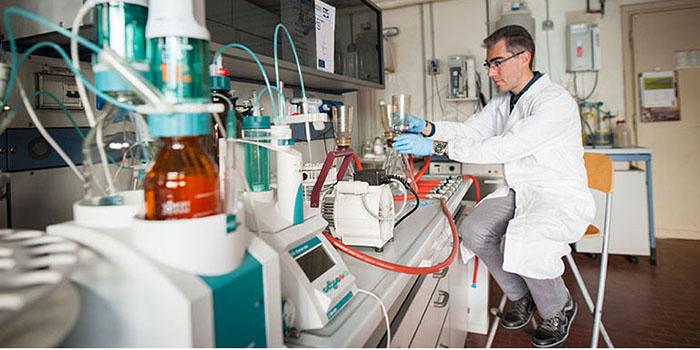
CHEMICAL RISK
Employers are required to assess the health risks for every worker present in the workplace, including exposure to chemical agents.
The chemical risk assessment begins with the inventory of substances and mixtures used by the worker.
For collecting information related to chemical substances used by workers at PoliTO, they are required to fill out the online SIR (Individual Hazard Recognition Form), which has been implemented on the Safety Live platform. The user logs into the platform, selects ‘Work Risk,’ and opens the section on chemical, carcinogenic, mutagenic, and reproductive toxic risks.
To identify hazardous chemical agents, the information written in the Safety Data Sheets (SDS) of the chemicals used is relied upon. The SDS also contains all chemical-physical and toxicological information, as well as useful data for managing substances and proper usage methods, both for health and the environment.
The SDS is provided by the manufacturer (as required by the European Union's Reach regulation) in paper or electronic format, in the language of the recipient country, and is organized into 16 sections:
In particular, the data that workers at the Polytechnic must enter into the online SIR can be found in the SDS sections:
1: Product name, CAS No. (a numerical identifier that uniquely identifies a chemical substance).
2: Identification of hazards: the H phrases or "Hazard Statements" are composed of the letter H followed by three numbers, where the first indicates the type of hazard (2 for physical hazard; 3 for health hazard; 4 for environmental hazard). When filling out the SDS, hazard indications starting with 2 and 3 are included.
The risk assessment of each chemical agent is also based on the quantities used, exposure time, the work environment, and the individual and collective PPE used; such information is also entered by the user.
CARCINOGENIC, MUTAGENIC, AND REPRODUCTIVE TOXICITY RISK.
Carcinogenic agents are substances or mixtures that cause cancer or increase its incidence.
Mutagenic agents are those with proven ability to cause hereditary mutations in human germ cells or considered capable of causing hereditary mutations in human germ cells.
Toxic substances for reproduction or repro-toxic substances are those that have harmful effects on sexual function, fertility of adult men and women, as well as on the development of offspring, and the effects manifest after exposure to a substance or mixture. (CLP)
WHAT TO DO EVERY TIME YOU INTEND TO USE A NEW CARCINOGENIC, MUTAGENIC, AND REPRODUCTION-TOXIC AGENT IN THE LABORATORY
WARNING! Before purchasing a carcinogenic/mutagenic/reproduction-toxic agent, it is necessary to request the authorization for use, to be sent to the Prevention and Protection Service, which must be signed (after various steps) by the Rector.
The authorization form includes the possibility of replacing the carcinogenic/mutagenic/reproduction-toxic agent.
This is because preventive measures aim to reduce the likelihood of causing harm to the health of workers.The regulation stipulates that CANCEROGENIC agents (H350), MUTAGENIC (H340), AND TOXIC FOR REPRODUCTION (H360) should be replaced with non-hazardous or less hazardous ones for health. This action would eliminate the risk directly at the source. If this is not possible, the number of exposed workers must be reduced, or procedures or processing systems that reduce risks must be introduced into the work environment. A key role is also played by training and informing exposed or potentially exposed workers. After approval of the authorization for use, the worker must fill out the online SIR (Individual Hazard Recognition Sheet), which has been implemented on the Safety Live platform. The user logs into the platform, selects 'Work Risk,' and opens the section on chemical risks, carcinogens, mutagens, and reproductive toxins.
Health Surveillance
The risk assessment of chemical agents, carcinogens, mutagens, and reproductive toxins will be made available to the competent doctor, who will decide what type of health surveillance the worker should undergo.
LABORATORY ACTIVITIES
Regarding:
- Behavioral rules to follow in the laboratory;
- Technical protective devices (fume hoods, cabinets, glove boxes) under which it is necessary to work depending on the toxicity and physical state of the agent, in accordance with the activity to be performed ;
- Personal Protective Equipment to be adopted based on the physical-chemical characteristics and toxicity of the agent to be handled;
- Characteristics of cabinets for storing chemical agents;
Refer to the ‘Guide to Safety in Chemical Laboratories’.
Regarding the use of carcinogenic, mutagenic, and toxic agents for reproduction, it is reminded that it is necessary to send quarterly, to infermeria@polito.it and in copy to servizio.prevenzione@polito.it, for each user, the personal record of the use of the carcinogenic agent ().
Note: concerning the exhaust systems, in the case of recirculating hoods or total extraction hoods, equipped with filters, it is necessary to verify the correspondence between the types of filters and the agents to be handled: if the filters are activated carbon, they are suitable for gases and vapors; if the filters are HEPA, they are suitable for powders. Similarly, it is necessary to verify the suitability of personal respiratory protective devices in relation to the agents handled: a filtering facepiece does not protect against vapors, it only protects against powders.
It is also necessary to verify that the hoods are subjected to periodic maintenance, particularly regarding the monitoring of the front air velocity of the suction air [based on what is indicated in standard EN 14175] and the replacement of filters. The maintenance technician must issue a written certification of the periodic checks, which must be kept and, if requested, transmitted to the Prevention and Protection Service.
HAZARDOUS WASTE MANAGEMENT
Waste produced by research activities must be properly collected, sorted according to the relevant CER code ('European Waste Catalogue') and hazard class, in appropriate containers that are durable and equipped with a containment tray in case of liquid waste. An identification label indicating the waste, CER code, and hazard class must be affixed to the containers. Mixing different types of waste is strictly prohibited.
For waste management, it is still necessary to refer to the department contact responsible for their disposal.